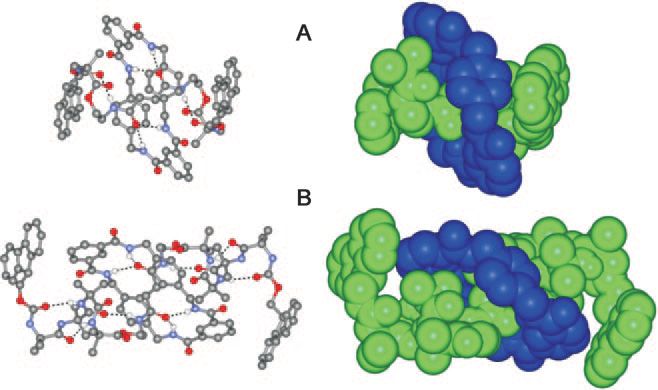Rotaxanes are tiny molecular structures where a central straight molecule passes through a macrocycle, making a molecular machine in the shape of an axle inside a wheel. Bulky stoppers at either end of the straight molecules keep the wheel on the axle. These molecular machines have the potential to be used as molecular shuttles by moving the wheel along the axle, which is of interest for nanoscale electronic components and also in biology, where many biochemical functions are based on molecular shuttles. Scientists from the University of Padova have been using Diamond to determine the structure of a rigid helical peptide axle for a Rotaxane molecular machine. This research has been published in the journal Angewandte Chemie.
The group from the Institute of Biomolecular Chemistry of CNR and the University of Padova have designed a series of peptido[2]rotaxanes which contained a rigid helical peptide helix as a significant part of their axle. They chose two symmetrical axles, each characterized by either two α-aminoisobutyric acid (Aib) residues or by two -(Aib)4- homopeptide ester sequences. These were studied on the I19 beamline, Small Molecule Single Crystal Diffraction to determine the structure.
 |
| Two representations each of the two X-ray diffraction structures of the symmetrical rotaxanes. Left: the carbon, oxygen, and nitrogen atoms are depicted in gray, red, and blue, respectively. The intramolecular C=O---H-N hydrogen bonds are shown as black dotted lines. Right: space-filling representations (macrocycle in blue and axle in green). Courtesy of Angewandte Chemie. |
Once these structures had been determined, it was possible to create a peptide [2]rotaxane molecular machine. Based on a non-symmetrical rotaxane they constructed a reversible molecular device where the wheel switches almost quantitatively between two, unambiguously identified, stations on changing the solvent. They also established that by virtue of the size of the inner cavity of the wheel relative to the outer diameter of the helix, a rotation of the wheel might occur concomitantly with its translation along the axle. Now the group are using a combination of spectroscopic methods and theoretical calculations to investigate the mechanism of the wrapping motion in the molecular machine in detail.
Marco Crisma took part in the study.
“The structure of our symmetrical peptido[2]rotaxane could have not been solved without the brilliance of synchrotron radiation, owing to the small size of the crystals. It is nice that Diamond has developed a beamline fully dedicated to small molecule crystallography, which requires a different approach in terms of data collection and processing if compared to macromolecular crystallography. As for our molecular machine, basically we have provided the proof of principle that a nut-and-bolt system can be reproduced at the nanometric scale. Next challenges will be to reach higher speed and to gain better control of the motion, perhaps by modifying the terminal stations and the external stimulus that triggers the movement.”Marco Crisma, Institute of Biomolecular Chemistry of CNR
A Rigid Helical Peptide Axle for a [2]Rotaxane Molecular Machine, Alessandro Moretto, Ileana Menegazzo, Marco Crisma, Elizabeth Shotton, Harriott Nowell, Stefano Mammi, Claudio Toniolo, Angewandte Chemie International Edition, 48(47), 8986-8989, 48, October 2009
DOI: 10.1002/anie.200904749
Diamond Light Source is the UK's national synchrotron science facility, located at the Harwell Science and Innovation Campus in Oxfordshire.
Copyright © 2022 Diamond Light Source
Diamond Light Source Ltd
Diamond House
Harwell Science & Innovation Campus
Didcot
Oxfordshire
OX11 0DE
Diamond Light Source® and the Diamond logo are registered trademarks of Diamond Light Source Ltd
Registered in England and Wales at Diamond House, Harwell Science and Innovation Campus, Didcot, Oxfordshire, OX11 0DE, United Kingdom. Company number: 4375679. VAT number: 287 461 957. Economic Operators Registration and Identification (EORI) number: GB287461957003.